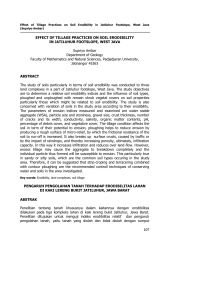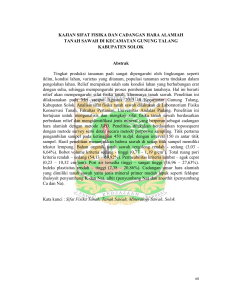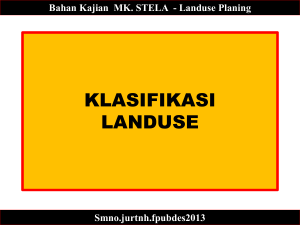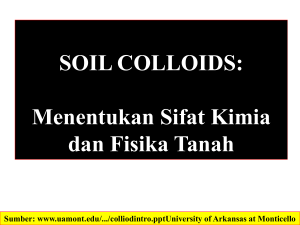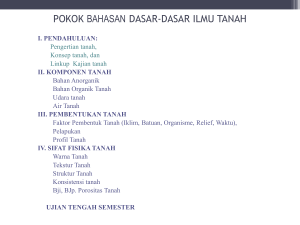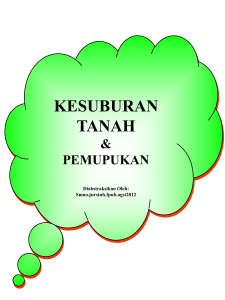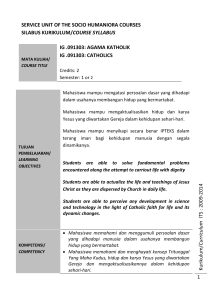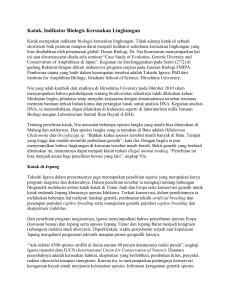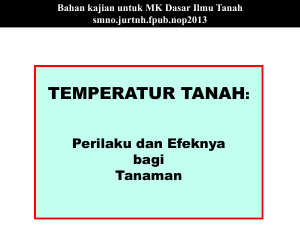Soil Science Simplified
advertisement
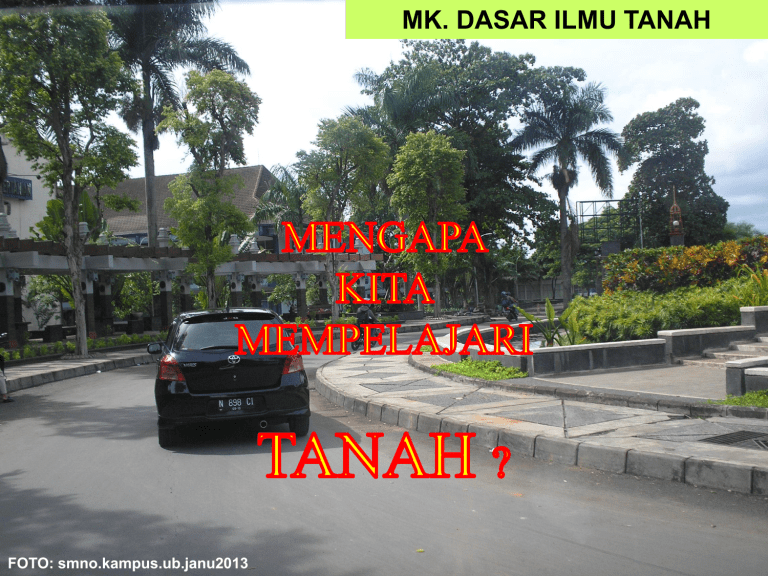
MK. DASAR ILMU TANAH
Soil Science Simplified
Ppt 1 - Intro
FOTO: smno.kampus.ub.janu2013
Mengapa kita mempelajari TANAH ?
TANAH sangat penting:
–
–
–
–
–
–
–
–
–
–
Media untuk produksi tanaman
Pembersih air dan limbah
Produsen dan penyerap gas-gas
Rumah bagi berbagai organisme
Medium untuk pertumbuhan tanaman
Dekomposer limbah
Sumber bahan untuk konstruksi , seni dan obat-obatan, dll.
Dokumen sejarah manusia, geologis, klimatis, dan biologis
Sumberdaya alam esensial.
Tempat mendirikan bangunan, dan lainnya.
HUBUNGAN TANAH DAN TANAMAN
Soil-Plant Nutrient Cycle.
Figure illustrates the uptake
of nutrients by plants in the
forest" soil ecosystem.
Source: U.S. Geological
Survey.
Diunduh dari: ……….. http://cnx.org/content/m41620/latest/
HUBUNGAN TANAH DAN TANAMAN
Plants as primary producers
require mineral elements which
they remove from the soil and
combine with Carbon Dioxide
(CO2) (from the Atmosphere) and
Water (H2O) (also taken from the
soil matrix) to produce the
sugars, carbohydrates and
proteins, required for growth.
Tanaman mendapatkan air dan
hara dari dalam tanah,
penyerapannya melalui bulu akar.
Diunduh dari: ……….. http://phasm.co.uk/guerrilla-soil-science/soil-properties/
HUBUNGAN TANAH DAN TANAMAN
Most of the water is
absorbed by the plants is
through root hair zone.
The figure shows the
pathway of soil water
into root system.
Diunduh dari: ……….. http://preuniversity.grkraj.org/html/4_PLANT_AND_WATER_RELATIONSHIP.htm
HUBUNGAN TANAH DAN TANAMAN
Figure :
(a) shallow soil
without a B
horizon has low
water storage
and can restrict
root growth and
(b) deeper soil with
all three
horizons with
no physical
constraints to
root growth
(Reference:senrm.s
a.gov.au).
Diunduh dari: ……….. http://festuca.weebly.com/
KUALITAS TANAH
Sifat Fisika
Kesuburan Tanah
Aktivitas Biologis
“The ability of soil to function; to supply
plants with adequate essential nutrients,
have good drainage and aeration, promote
root growth and soil biological activities.”
KUALITAS TANAH
Konteks: Tipe Tanah, Slope, Iklim…….
Problem
- Salinitas
Kualitas Tanah
Tanah …OK
- Kaya BOT
- Miskin Hara
- Sifat Olah
- Erosi tanah
- Infiltrasi Air
- Drainage
- Ketersediaan Hara
EMPAT KOMPONEN TANAH
minerals
(sand, silt,
clay)
45%
water
25%
BOT
5%
air
25%
SIFAT DAN FUNGSI TANAH
1. Tanah = Soil – selimut tipis di permukaan bumi,
terdiri atas bahan mineral dan bahan organik, air dan
udara dan mampu mendukung pertumbuhan
tanaman.
2. Fotosintesis – plant ability to combine CO2 and H2O
from the ground into sugar (C6H12O6). Light furnishes
the energy for this reaction. Nitrogen, sulfur and
phosphorus are required for synthesis of plant
proteins too.
SIFAT DAN FUNGSI TANAH
1. Sebagai medium tumbuh tanaman, tanah memainkan
empat fungsi:
1.
2.
3.
4.
Jangkar akar tanaman
Suplai air
Menyediakan udara
Menyediakan unsur hara tanaman
2. Ruang pori di antara padatan tanah diisi oleh air dan udara.
3. Air takes up part of the pore space not occupied by water.
As the water increases, the air content decreases. In
respiration (opposite of photosynthesis), plant roots use
oxygen and give off carbon dioxide. So, soil usually
contains less oxygen and more carbon dioxide than
atmospheric air does.
4. Millions of microbes live in each ounce of fertile soil.
Without them, soils would become inactive and lose their
ability to support plants.
TANAH SBG MEDIA TUMBUH TANAMAN
• Soils and growing media are made up of two
types of materials:
– Bahan organik Tanah (BOT)
– Bahan / senyawa anorganik
PROFIL TANAH
• Lapisan-lapisan dalam profil tanah disebut
“horizon”
• Profil tanah yang khas:
– Horizon A atau Topsoil
• most fertile
• most organic matter
• top or first layer
– Horizon B atau Subsoil
– Horizon C atau Batuan induk
PROFIL TANAH
Sumber: http://www.eoearth.org/article/Soil
Most soils have a distinct profile or sequence of horizontal layers. Generally,
these horizons result from the processes of chemical weathering, eluviation,
illuviation, and organic decomposition. Up to five layers can be present in a
typical soil: O, A, B, C, and R horizons.
The O horizon is the topmost layer of most soils. It is composed mainly of
plant litter at various levels of decomposition and humus.
A horizon is found below the O layer. This layer is composed primarily of
mineral particles and has two characteristics: it is the layer in which humus
and other organic materials are mixed with mineral particles, and it is a zone
of translocation from which eluviation has removed finer particles and soluble
substances, both of which may be deposited at a lower layer. Thus the A
horizon is dark in color and usually light in texture and porous. The A horizon
is commonly differentiated into a darker upper horizon or organic
accumulation, and a lower horizon showing loss of material by eluviation.
The B horizon is a mineral soil layer which is strongly influenced by illuviation.
Consequently, this layer receives material eluviated from the A horizon. The B
horizon also has a higher bulk density than the A horizon due to its
enrichment of clay particles. The B horizon may be colored by oxides of iron
and aluminum or by calcium carbonate illuviated from the A horizon.
Typical layers found in a soil profile.
(Source: PhysicalGeography.net)
The C horizon is composed of weathered parent material. The texture of this
material can be quite variable with particles ranging in size from clay to
boulders. The C horizon has also not been significantly influenced by the
pedogenic processes, translocation, and/or organic modification.
PROFIL TANAH
Soil Profile: a vertical section of soil from the
ground surface to the parent rock
Soil Profile :
Soil typically consists of layers of material,
called horizons, which differ in both texture
and appearance.
A soil profile is a cross section of these
layers, and it measures the different
characteristics of each layer.
Sumber:
http://topics.wisegeek.com/topics.htm?soil-profile#
PROFIL TANAH
Sumber:
http://saburchill.com/lab/field/fiel
d02.html
There are four distinct layers of
soil under the leaf litter.
1. Leaf Litter (Layer A)
2. Humus (Layer B)
3. Humus with some
minerals (Layer C)
4. Minerals with very little
humus (Layer D)
PROFIL TANAH
Soil profile and names of horizons
Hypothetical soil profiles with example of codes
for horizons.
L (or F): Litter (Förna = litter)
0: Litter layer of not or little decomposed plant
material
A: Eluviation layer, divided into:
A1: Upper layer, dark in color, very rich in
humus
A2: Mineral layer relatively poor in clay
material, iron, aluminium or all three due to
leaching
B: Illuviation horizon, divided into:
B1: Gradual transition layer from A2 to B2
B2: Layer with maximal illuviation
B3: Gradual transition from B2 to a C-horizon.
C: Unconsolidated earth material. Not or only
little weathered material
g: g indicates the layers where iron, sedimented
under anaerobe conditions, became oxidized
later to ironoxide or rost
Sumber: http://www.vcbio.science.ru.nl/en/virtuallessons/landscape/soil/
G: G indicates the permanent non-aerate or
poorly aerate parts of the soil, characterized by
the blue-gray color of ironsulfide (FeS = pyrite).
These layers are mostly in the deeper part of
the profile.
PROFIL TANAH
Diunduh dari sumber: http://www.as.wvu.edu/~rbrundage/lecture7b/sld004.htm
SIFAT FISIKA TANAH
• Soils consist of solid,
liquid, gaseous and biotic
components.
• Sand and silt are merely
broken down rock frags
(consists of quartz,
feldspar, mica, or other
minerals). Chemically
they are essentially inert
compared with clay and
organic matter, which are
responsible for most of
the chemical reactions in
the soil.
Soil
fraction
Gravel
Sand
Silt
Clay
Diameter
Larger
than 2
mm
0.05 - 2
mm
0.002 –
0.05 mm
Smaller
than
0.002 mm
Descriptio
n
Coarse
Gritty
Floury
Sticky
when wet
LIAT = CLAY
1. Clay particles are plastic and
sticky when wet. They are highly
adsorptive of water, gas, and
dissolved substances.
2. Liat berukuran halus, bentuk
pipih; kristal aluminosilicate
terdiri atas Si, Al, Fe, Mg, O, dan
H.
3. Ada beberapa tipe liat, dua tipe
liat yang sangat penting adalah
kaolinite dan smectite. Smectite
clays have the ability to swell on
wetting and shrink when dry.
LIAT = CLAY
1. Liat adalah koloid yang bermuatan negatif. This
negative charge is the reason that positively charged
cations surround each clay particle. The individual
cations can be exchanged for each other.
2. Kalau kation dapat mendekati permukaan liat,
muatan negatif pada permukaan liat akan dinetralisir
dan partikel-partikel liat akan saling berikatan dengan
jembatan kation atau liat mengalami flokulasi.
3. Ca dan Mg menjadi jembatan pengikat partikelpartikel liat menjadi flokul. Kedua kation ini
ukurannya cukup kecil dan efektif mengikat bersama
partikel-partikel liat.
TEKSTUR TANAH
• TEKSTUR TANAH – PROPORSI RELATIF berbagai
ukuran partikel (separat) dalam tanah.
• Nama-nama kelas tekstur tanah, mis. Pasirberlempung (Loamy sand), Lempung-debu (Silt
loam), Lempung-liat (Clay loam) dan Liat-berdebu
(silty clay).
• The best soils are generally those which contain 10
to 20% clay, with silt and sand in approximately
equal amounts, and a fair amount of organic
matter.
SEGITIGA TEKSTUR TANAH
The content of sand, silt,
and clay for the twelve
main soil texture classes
can be found on this
triangle.
Misalnya tekstur
Lempung berpasir
(Sandy loam )
mengandung 65% pasir,
25% debu (silt), dan
10% liat (clay).
LUAS PERMUKAAN
• In comparing clay
with sand and silt, it
is important to be
aware of the relative
amount of surface
area of these
particle size groups,
bc it is on the
surface that many
chemical and
physical processes
take place.
• Partikel yang
ukurannya lebih
kecil = luas
permukaannya
lebih besar
(misalnya Liat)
Sumber referensi: ………
PARTIKEL PRIMER TANAH
Partikel Tanah
Diameter
Partikel
Partikel dalam 1
gram
Luas
permukaan dari
1 gram
PASIR = Sand
2 mm
90
11 cm2
DEBU = Silt
0.02 mm
90,000,000
(9x107)
1130 cm2
LIAT = Clay
0.0002 mm
9x1013
113,000 cm2
STRUKTUR TANAH
• STRUCTUR TANAH – tatanan individual partikel-partikel
dalam hubungan satu sama lain. Struktur tanah merupakan
tatanan partikel-partikel menjadi “kelompok kecil” atau
disebut agregat tanah.
• Agregat-agregat kecil dapat berikatan satu sama lain menjadi
agregat yang lebih besar , disebut Gumpalan (ped).
• Gumpalan (bongkahan, Ped) bentuknya bermacam-macam ,
membulat, balok , kolom, pipih.
• If the individual particles are arranged in small aggregates
with rounded edges, we speak granular structure. This is
very desirable for plant growth bc it provides both large and
small pores.
• Bebertapa tanah strukturnya tidak ada. Sandy soils the
individual grains act independently of each other. No
binding substances hold the particles together, so the soil
has no peds.
STRUKTUR TANAH
• Bagaimana partikel-partikel tanah
berkelompok:
– Butiran tunggal
– Granular (best for most plants)
– Balok - blocky
– Pipih - platy
– Masif - massive
STRUKTUR TANAH
Single Grain
STRUKTUR TANAH
Remah - Granular
Gumpal Blocky
STRUKTUR TANAH
Pipih - Platy
Massive
STRUKTUR TANAH
• Struktur tanah sangat penting bagi petani
yang menanam tanaman pada kondisi tanah
alamiah
• Producers of container grown plants add
ingredients to make growing media desirable
TEKSTUR TANAH
• Ukuran partikel
• Tipe tekstur
– Berliat
– Berlempung
– Berpasir
TEKSTUR BERLIAT
1. Partikel-partikel halus
2. Mempunyai kemampuan
besar untuk
menahan/menyimpan
air
TEKSTUR BERLEMPUNG
• Kelas tekatur lempung
mempunyai pasir, bedu
dan liat hampir sama
• Tekstur ini sangat ideal
bagi pertumbuhan
tanaman secara umum
TEKSTUR BERPASIR
• Partikel ukuran besar
• Kemampuan
menyimpan air sangat
rendah
PORI TANAH
1. Pori ukuran besar mudah merembeskan air dan
diisi udara setelah hujan lebat. Pori ini sangat
penting bagi sistem aerasi tanah.
2. Pori ukuran kecil (pori mikro) menahan air
melawan gaya gravitasi dan dapat mendorong air
ke arah atas dari muka-air dengan cara kapilaritas..
Pori ini penting dalam suplai air bagi tanaman.
3. Ideal structure includes large and small pores in
proportions that corresponds to the water/air
needs of the crop plants given for that culture or
climate.
TEMPERATUR TANAH
1. Just as important to plant growth as air temp. The
temp of the surface soil fluctuates greatly both
during a 24 hr period and with the seasons.
2. Kalau permukaan tanah tertutup dengan tanaman
yang rapat atau lapisan mulsa yang tebal, variasi
dan fluktuasi suhu tidak terlalu besar dan fluktuasi
suhu tidak menembus lapisan tanah yang dalam
3. Suhu tanah mempunyai efek langsung terhadap
pertumbuhan tanaman dan juga mempengaruhi
aktivitas mikroba tanah;
4. Freezing and thawing of the soil water also affects
soil structure. Slow and occasional freezing and
thawing (like under mulch) is beneficial for soil
structure.
WARNA TANAH
1. Warna tanah dapat mengisyaratkan sifat-sifat lainnya.
2. The color of a surface soil horizon depends mainly on its
organic matter content – the darker the soil, the more organic
matter it contains. This organic matter imparts favorable
properties to the soil, such as better aggregation and a high
water-holding capacity. Also, dark soils absorb more radiation
during the day, and radiate more heat during the night.
3. Dalam subsoil, warna tanah menyatakan kondisi kebasahan
dan aerasi tanah.
4. Umumnya, subsoil yang kemerahan dan kecoklatan
mencerminkan aerasi yang bagus dan tidak ada (sedikit saja)
genangan air
5. Warna kelabu dan olive menyatakan kondisi genangan air dan
reduksi kimiawi besi.
6. A mottled subsoil, one with a splotchy pattern of brownish and
grayish colors, is indicative of a fluctuating ground water table.
Munsell Color System
• Defined color in terms of Hue, Value and Chroma.
• Hue was defined as the actual color, red, blue,
green, etc.
• Value was defined as how light or dark a color is.
• Chroma was defined as how strong or weak a color
is.
• Soil scientists use the Munsell Color book to
determine the color of the soil to help determine in
what type of soil it is along with using texture.
BAHAN ORGANIK TANAH = BOT
• Jaringan tumbuhan
dan binatang yang
telah mati
• Mengandung carbon
TIPE BAHAN ORGANIK
1. Kompos
2. Seresah sisa-sisa tumbuhan
3. Mulsa untuk menutupi
permukaan tanah,
membantu menyimpan air
tanah dan mencegah
pertumbuhan gulma
4. Jerami sisa panen tanaman
5. Gambut
6. Pupuk Hijau
BIOLOGI TANAH
• Organisme hidup dalam tanah
• Termasuk mikro dnd makro flora dan fauna.
Tumbuhan:
– Mikro-flora
• Bacteria
• Fungi
• Actinomycetes
– Makro – akar tanaman
BIOLOGI TANAH
Fauna:
– Mikro fauna
• Nematoda
• Protozoa
– Makro fauna
•
•
•
•
Cacing tanah
Rodents (prairie dogs, moles, gophers, etc.)
Arthropods (mites, insects, spiders, etc.)
Gastropods (slugs, snails, etc.)
BIOLOGI TANAH:
JARING-JARING MAKANAN
ORGANISME TANAH
• Macroflora
• Microflora
• Macrofauna
Vascular plants, mosses (autotrophs)
Vascular plants (root hairs), algae, actinomycetes,
bacteria, and fungi
(auto- and heterotrophs)
Vertebrates, arthropods, earthworms, snails…
(herbivores, detritivores, predators)
• Mesofauna
Arthropods, worms (detritivores, predators)
• Microfauna
Nematodes, protazoa… (detritivores, fungivores,
bacterivores, predators)
Satu sendok tanah mengandung…....
Microflora,
or “microbes”
Mikrofauna
Macro- and
mesofauna
Bacteria 200 billion
{ Fungi
100,000 meters
Protozoa 20 million
{ Nematodes 100,000
Arthropods
{ Earthworms
50,000
<1
Immobile organisms all primarily found in the rhizosphere, the zone of
soil closest to plant roots
MIKROFLORA TANAH
1. Heterotrophs (bacteria, fungi) & autotrophs (algae,
cyanobacteria)
2. Dekomposer utama
3. Melepaskan unsur hara yang tersedia bagi tanaman
4. Menstabilkan agregat (gumpalan) tanah
hyphae
clay
Aggregat tanah
diikat bersama
oleh:
sand
silt
– Hifa fungi
– “Glues” bakteri
– Bahan organik
bacteria
Sumber:
FUNGI TANAH
1. Agen pelapukan yang utama dalam
lingkungan tanah masam
2. Jaringan hifa: memperbaiki struktur tanah
3. Dekomposisi selulose
4. Dapat bersaing dengan tanaman untuk
mendapatkan nitrogen dari tanah
Microflora –
BAKTERI TANAH
1. Ada dalam tanah-tanah hutan dan tanah pertanian
2. Ada yang bersifat Aerobik, anaerobik, dan
fakultatif
3. Ada yang bersifat Autotrofik dan heterotrofik
4. Most do best under high Ca2+, high pH
5. Do best when soil temp 20-40C (68-100F) but
seldom killed by temperature extremes
Fungi vs. Bakteria
Fungi
Tubuhnya seperti
tabung (benang); hifa
Aerobik
Umumnya
pertumbuhannya lebih
lambat
Bakteria
Ber-sel tunggal, dapat
membentuk koloni
Ada spesies yang bersifat
Aerobik, anaerobik, dan
fakultatif
Waktu regenerasinya cepat (jamjama an); respon cepat terhadap
penambahan hara ke tanah
MIKROFAUNA
Microfauna TANAH
Ciliate
• Heterotrof; beberapa parasitik
Flagellate
• Memangsa bacteria dan fungi
• Melepaskan hara tanaman dalam
proses mineralisasi
(dekomposisi) bahan organik
tanah – protozoa KEY for N
Amoebae
Nematode
Nematode
NEMATODES
(non-segmented, round worms)
– Banyak ditemukan dalam tanah-tanah hutan
– Kelompok-kelompok Saprofitik dan parasitik
– Beberapa spesies predator menyerang akar
pohon dan menyebabkan kerusakan
PROTOZOA TANAH
– Fauna tanah yang paling banyak jumlahnya
– Ber-sel tunggal
– Memangsa bakteri
– Up to 30% of all mineralized N from protozoa
MESOFAUNA TANAH
1.
Heterotroph (detritivora,
predator)
2. Memangsa fungi,
protozoa, nematoda,
mite
3. Penting dalam
mengendalikan populasi
jenis-jenis yang lebih
kecil
MAKROFAUNA TANAH
1. Heterotrophs
2. “shred” material
tumbuhan
3. Memangsa bakteria dan
fungi yang berhubungan
dnegan bahan organik
CACING TANAH
1. Probably the most important component of soil fauna
(not in acid soils, not in very dry soils)
2. Pass as much as 30 tons/ha of soil through their bodies
each year
3. Menghasilklan kotoran cacing yang kaya hara N, P, K, Ca,
Mg, pH, dan KTK
4. Membantu pembentukan struktur tanah yang baik dan
aerasi tanah.
KOTORAN CACING TANAH vs. TANAH
Characteristic
Earthworm casts
silt & clay (%)
Soils
22.2
38.8
Bulk density (g/cm3)
1.11
Structural stability
849
CEC (cmolc/kg)
13.8
1.28
65
3.5
Ecosystem Function –
Influence of soil biota on soil processes
Nutrient cycling
Soil structure
Microflora
Break up O.M., mineralize
and immobilize nutrients
Bind aggregates,
hyphae entangle
particles
Microfauna
Regulate bacterial and
fungal populations
Indirectly affect
structure
Mesofauna
Regulate above pops.;
fragment plant tissue
Fecal pellets, pores
Macrofauna
Fragment plant tissue
Mix O.M. and mineral
soil; pores; feces
FUNGSI EKOSISTEM TANAH
Rate of decomposition depends on:
•
•
•
Physical and chemical nature of the litter material
Temperature and moisture of the soil environment
Aeration (vs. anaerobic)
• The kinds and numbers of soil fauna
More bugs, and more different kinds of bugs, means more
decomposition
SIFAT KIMIA TANAH
Kemampuan tanah menyediakan hara
esensial bagi tanaman mencakup:
1. Ketersediaan unsur hara
2. Sifat kimiawi lainnya:
–
–
–
–
Mineral liat
Kandungan humus
Kation tukar
Reaksi tanah (pH).
HARA TANAMAN YANG BERASAL DARI UDARA
DAN AIR
• Carbon
• Hydrogen
• Oxygen
Tanaman menyerap CO2 dari udara melalui
stomata daun (mulut daun)
Tanaman menyerap air (H2O) dari dalam tanah
melalui bulu akar (root hairs)
CO2 dan H2O digunakan oleh tanaman dalam
proses fotosintesis yang berlangsung dalam
khlorofil.
HARA PRIMER
KALIUM
Nitrogen
FOSFOR
HARA SEKUNDER
Calcium
Magnesium
Sulfur
HARA MIKRO
•
•
•
•
•
•
•
Boron
Chlorine
Copper
Iron
Manganese
Molybdenum
Zinc
16 HARA ESENSIAL
•
•
•
•
•
•
•
•
Boron
Calcium
Carbon
Chlorine
Copper
Hydrogen
Iron
Magnesium
Manganese
Molybdenum
Nitrogen
Oxygen
Phosphorus
Potassium
Sulfur
Zinc
FUNGSI HARA PRIMER &
GEJALA DEFISIENSI HARA
• Nitrogen (N): unsur hara sangat penting yang
menentukan laju pertumbuhan tanaman
– Gejala defisiensinya: daun menguning
• Phosphorous (P): required during germination and
fruit/seed formation
– Deficiency symptoms: stunted growth; purple-colored
leaves
• Potassium (K): fungsi regulator
– Gejala defisiensinya: Pertumbuhan kerdil; daun
berbecak-becak.
MENGAPA MEMPELAJARI HARA DALAM
TANAH ?
1. Untuk memaksimumkan hasil tanaman
2. Untuk memaksimumkan keuntungan
3. Untuk memelihara kesuburan tanah
MENENTUKAN KESUBURAN TANAH
Metode untuk menentukan kesuburan tanah :
• Uji tanah = soil test
• Pengelolaan bahan organik
• Pemupukan.
pH = Kemasaman tanah
1. Ukuran kemasaman atau kebasaan,
nilainya 0 - 14
2. Acid – pH < 7.0
3. Alkalis – pH > 7.0
4. Most organic matter is acid
5. Most artificial media is neutral
6. Ideal pH for most ornamental plants and
lawn or turf grasses is 5.5 to 7.0
pH = Kemasaman tanah
Neutral
Sumber: Brady and Weil (2002)
pH = - log (H+ ion concentration)
pH
=7
neutral
increases…
As pH decreases…
Brady and Weil, 2002
Setiap jenis tanaman memerlukan kisaran pH optimum
tertentu
Bentuk-bentuk kemasaman tanah
pH tanah
merupakan ukuran
kemasaman aktif
Kemasaman Cadangan
= Potensial
Active
acidity
Sumber: Brady and Weil, 2002
Reaksi kesetimbangan ion-ion dalam tanah
K+
Ca+2
Mg+2
- --Humus
-
H+
H20
Exchangeable
exchangeable
acidity
cations
H20
H20
Clay
SO4
-2
++
-Al
- K
+3
--
H20
soil
solution
H20
H20
+ H2O ↔ Al(OH)3 + 3H+
+
Ca+2
Apa “Kejenuhan
Basa” ?
Apakah pH berhubungan dengan kenenuhan basa ?
100
80
60
Acid Saturation, %
40
20
0
Muatan-listrik yang tergantung pH
The dominant clay
minerals in IL have
mostly permanent
charge
Muatan pada substansi
humik (dan liat yg
aktivitasnya rendah) sangat
tergantung pH
Kation H+ mengalami disosiasi kalau pH tanah naik, dan kation H+
mengalami re-asosiasi kalau pH turun.
Sumber: Brady and Weil (2002)
Proses yang menghasilkan H+ ke tanah:
1) Asam karbonat terbentuk ketika CO2 larut dalam air.
Kation H+ dilepaskan kalau asam karbonat berdisosiasi:
H2CO3 → HCO3- + H+
2) Organic acids form during the decomposition of organic matter.
H+ ions are released when these organic acids dissociate.
3) Sulfuric and nitric acids form during the oxidation of reduced forms of N and S
(e.g., NH4+ from fertilizer, elemental S).
NH4+ + O2 → NO3- + 2H+
S0 + O2 → SO4-2 + 2H+
4) Sulfuric and nitric acids form when sulfur oxides and nitric oxides (released into
the atmosphere by automobile emissions, industry smoke stacks, volcanoes,
forest fires) dissolve in precipitation. H2SO4 and HNO3 are strong acids and fully
dissociate in water.
5) Akar tanaman melepaskan H+ untuk menjaga keseimbangan muatan-listrik
internal ketika proses penyerapan kation melebihi penyerapan anion.
Proses-proses yang memerlukan kation H+ dalam
tanah:
1) Pelapukan mineral (mis. silicates, carbonates…)
2) Dekomposisi anion organik
3) Reduksi bentuk-bentuk oksidatif dari N, S dan Fe.
4) Roots release OH- or HCO3- to balance internal charge when anion uptake
exceeds cation uptake
5) Inner sphere adsorption of anions (especially sulfate) which displaces
hydroxyl (OH-) groups
Sumber-sumber penyangga pH dalam tanah
Carbonates
Hubungan pH dengan
kejenuhan Al
Sumber: Chadwick and Chorover ( 2001)
Pertumbuhan tajuk seimbang
dengan pertumbuhan akarnya
K+
H+
Rhizosfir = zone di sekitar
permukaan akar tanaman
NO3-
?
pH rhizosfir tanaman
berubah karena
tanaman
mengendalikan
keseimbangan muatanlistrik internalnya.
